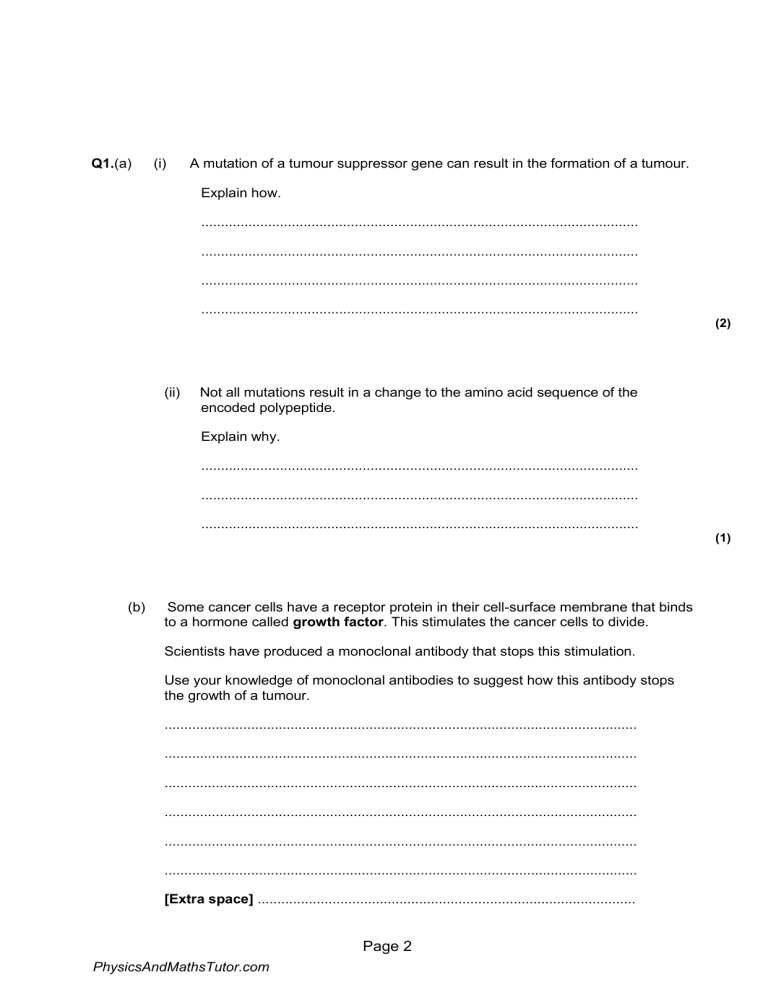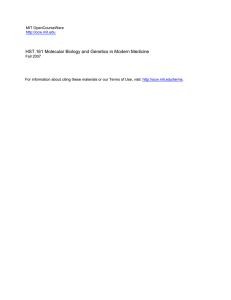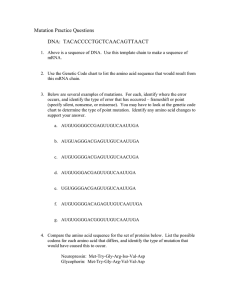
Q1.(a) (i) A mutation of a tumour suppressor gene can result in the formation of a tumour. Explain how. ............................................................................................................... ............................................................................................................... ............................................................................................................... ............................................................................................................... (2) (ii) Not all mutations result in a change to the amino acid sequence of the encoded polypeptide. Explain why. ............................................................................................................... ............................................................................................................... ............................................................................................................... (1) (b) Some cancer cells have a receptor protein in their cell-surface membrane that binds to a hormone called growth factor. This stimulates the cancer cells to divide. Scientists have produced a monoclonal antibody that stops this stimulation. Use your knowledge of monoclonal antibodies to suggest how this antibody stops the growth of a tumour. ........................................................................................................................ ........................................................................................................................ ........................................................................................................................ ........................................................................................................................ ........................................................................................................................ ........................................................................................................................ [Extra space] ................................................................................................ Page 2 PhysicsAndMathsTutor.com ........................................................................................................................ ........................................................................................................................ (3) (Total 6 marks) Q2.The diagram below represents one process that occurs during protein synthesis. (a) Name the process shown. ........................................................................................................................ (1) (b) Identify the molecule labelled Q. ........................................................................................................................ (1) (c) In the diagram above, the first codon is AUG. Give the base sequence of: the complementary DNA base sequence ..................................................... the missing anticodon ................................................................................... (2) The table below shows the base triplets that code for two amino acids. Amino acid Encoding base triplet Page 3 PhysicsAndMathsTutor.com (d) Aspartic acid GAC, GAU Proline CCA, CCG, CCC, CCU Aspartic acid and proline are both amino acids. Describe how two amino acids differ from one another. You may use a diagram to help your description. ........................................................................................................................ ........................................................................................................................ ........................................................................................................................ (1) (e) Deletion of the sixth base (G) in the sequence shown in the diagram above would change the nature of the protein produced but substitution of the same base would not. Use the information in the table and your own knowledge to explain why. ........................................................................................................................ ........................................................................................................................ ........................................................................................................................ ........................................................................................................................ ........................................................................................................................ ........................................................................................................................ (Extra space) ................................................................................................ ........................................................................................................................ ........................................................................................................................ (3) (Total 8 marks) Page 4 PhysicsAndMathsTutor.com Q3.(a) Messenger RNA (mRNA) is used during translation to form polypeptides. Describe how mRNA is produced in the nucleus of a cell. ........................................................................................................................ ........................................................................................................................ ........................................................................................................................ ........................................................................................................................ ........................................................................................................................ ........................................................................................................................ ........................................................................................................................ ........................................................................................................................ ........................................................................................................................ ........................................................................................................................ ........................................................................................................................ ........................................................................................................................ (6) (b) Describe the structure of proteins. ........................................................................................................................ ........................................................................................................................ ........................................................................................................................ ........................................................................................................................ ........................................................................................................................ ........................................................................................................................ ........................................................................................................................ ........................................................................................................................ ........................................................................................................................ ........................................................................................................................ ........................................................................................................................ Page 5 PhysicsAndMathsTutor.com ........................................................................................................................ (5) (c) Describe how proteins are digested in the human gut. ........................................................................................................................ ........................................................................................................................ ........................................................................................................................ ........................................................................................................................ ........................................................................................................................ ........................................................................................................................ ........................................................................................................................ ........................................................................................................................ ........................................................................................................................ ........................................................................................................................ ........................................................................................................................ ........................................................................................................................ (4) (Total 15 marks) Q4.Read the following passage carefully. A large and growing number of disorders are now known to be due to types of mitochondrial disease (MD). MD often affects skeletal muscles, causing muscle weakness. We get our mitochondria from our mothers, via the fertilised egg cell. Fathers do not pass on mitochondria via their sperm. Some mitochondrial diseases are caused by mutations of mitochondrial genes inside the mitochondria. Most mitochondrial diseases are caused by mutations of genes in the cell nucleus that are involved in the functioning of mitochondria. These mutations of nuclear DNA produce recessive alleles. One form of mitochondrial disease is caused by a mutation of a mitochondrial gene that codes for a tRNA. The mutation involves substitution of guanine for adenine in the DNA base sequence. This changes the anticodon on the Page 6 PhysicsAndMathsTutor.com 5 10 tRNA. This results in the formation of a non-functional protein in the mitochondrion. There are a number of ways to try to diagnose whether someone has a mitochondrial disease. One test involves measuring the concentration of lactate in a person’s blood after exercise. In someone with MD, the concentration is usually much higher than normal. If the lactate test suggests MD, a small amount of DNA can be extracted from mitochondria and DNA sequencing used to try to find a mutation. 15 Use information in the passage and your own knowledge to answer the following questions. (a) Mitochondrial disease (MD) often causes muscle weakness (lines 1–3). Use your knowledge of respiration and muscle contraction to suggest explanations for this effect of MD. ........................................................................................................................ ........................................................................................................................ ........................................................................................................................ ........................................................................................................................ ........................................................................................................................ ........................................................................................................................ (Extra space) ................................................................................................ ........................................................................................................................ ........................................................................................................................ (3) Two couples, couple A and couple B, had one or more children affected by a mitochondrial disease. The type of mitochondrial disease was different for each couple. None of the parents showed signs or symptoms of MD. • • (b) Couple A had four children who were all affected by an MD. Couple B had four children and only one was affected by an MD. Use the information in lines 5–9 and your knowledge of inheritance to suggest why: • • all of couple A’s children had an MD only one of couple B’s children had an MD. Couple A ........................................................................................................ Page 7 PhysicsAndMathsTutor.com ........................................................................................................................ ........................................................................................................................ ........................................................................................................................ Couple B ........................................................................................................ ........................................................................................................................ ........................................................................................................................ ........................................................................................................................ (Extra space) ................................................................................................ ........................................................................................................................ ........................................................................................................................ ........................................................................................................................ (4) (c) Suggest how the change in the anticodon of a tRNA leads to MD (lines 10–13). ........................................................................................................................ ........................................................................................................................ ........................................................................................................................ ........................................................................................................................ ........................................................................................................................ ........................................................................................................................ (Extra space) ................................................................................................ ........................................................................................................................ ........................................................................................................................ (3) (d) If someone has MD, the concentration of lactate in their blood after exercise is usually much higher than normal (lines 15–17). Suggest why. ........................................................................................................................ Page 8 PhysicsAndMathsTutor.com ........................................................................................................................ ........................................................................................................................ ........................................................................................................................ ........................................................................................................................ ........................................................................................................................ (Extra space) ................................................................................................ ........................................................................................................................ ........................................................................................................................ (3) (e) A small amount of DNA can be extracted from mitochondria and DNA sequencing used to try to find a mutation (lines 18–19). From this sample: • • how would enough DNA be obtained for sequencing? how would sequencing allow the identification of a mutation? ........................................................................................................................ ........................................................................................................................ ........................................................................................................................ ........................................................................................................................ (2) (Total 15 marks) Page 9 PhysicsAndMathsTutor.com




